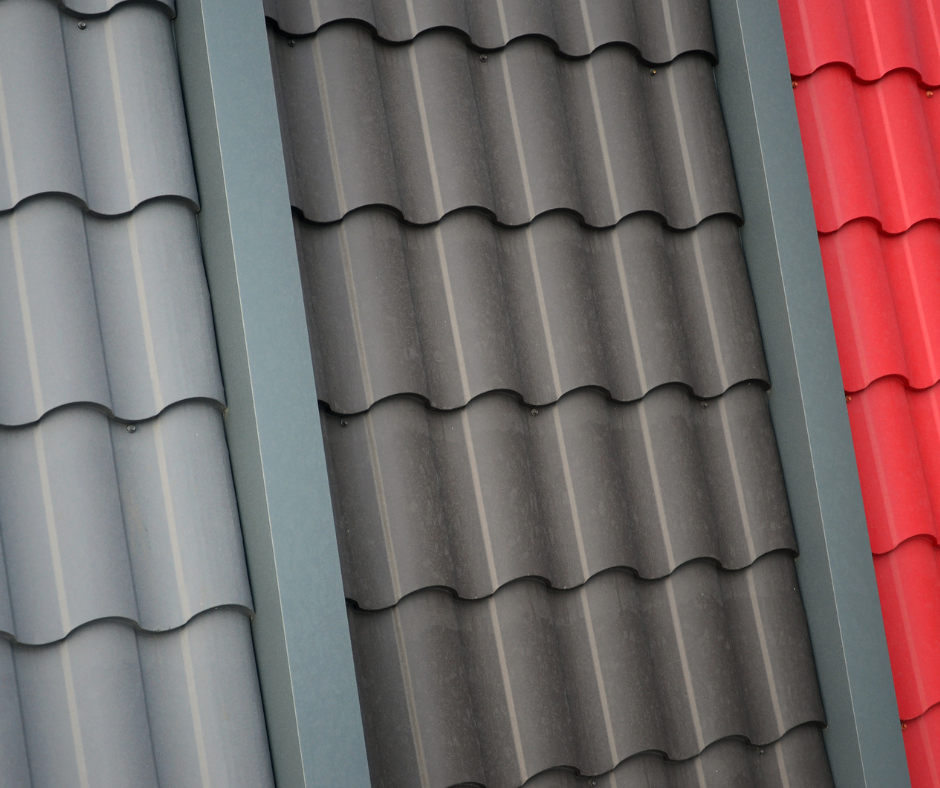
Painting a metal roof can revitalize its appearance and extend its lifespan. This guide will help you understand how can you paint a metal roof–what goes into painting it and ensuring you understand everything from the initial preparation to the final step of applying paint.
Whether you’re tackling an existing metal roof or considering a new coating for newer roofs, this guide ensures your painting project achieves professional results.
What are the Benefits of Painting a Metal Roof Yourself?
Taking on a DIY painting project for your metal roof brings several advantages, including significant cost savings as you avoid professional labor fees. By choosing to paint it yourself, you gain the flexibility to select the best paint and materials, such as high-quality metal primer and durable acrylic or latex paint, ensuring your roof’s appearance and longevity
Additionally, painting your metal roof can increase its energy efficiency. Reflective paint helps reflect sunlight, reducing cooling costs during warmer months.
Finally, painting your roof boosts your home’s curb appeal and extends its lifespan by adding a protective layer against UV rays and other elements.
Learn How to Paint a Metal Roof
Metal Roofing Painting Prep In a Nutshell
Preparing to paint a metal roof involves several key steps that are important for ensuring the paint adheres properly, and the final result looks professional.
Start by thoroughly cleaning the roof to remove dirt, debris, or rust. Use a pressure washer for an effective cleanse.
Next, use a wire brush or sandpaper to remove any loose paint and smooth out rough patches, paying special attention to rusty areas that might compromise the paint’s adherence. Repair any damage, such as small holes or leaks, to ensure a uniform surface.
Applying a high-quality metal primer is essential. This base coat aids the paint’s durability and adherence, setting the stage for a successful metal roof painting project.
By following these prep steps, you ensure that the roof is prepared for painting, which will improve both the application process and the longevity of the painting job.
Roof Painting Requires Quality Primer & Paint
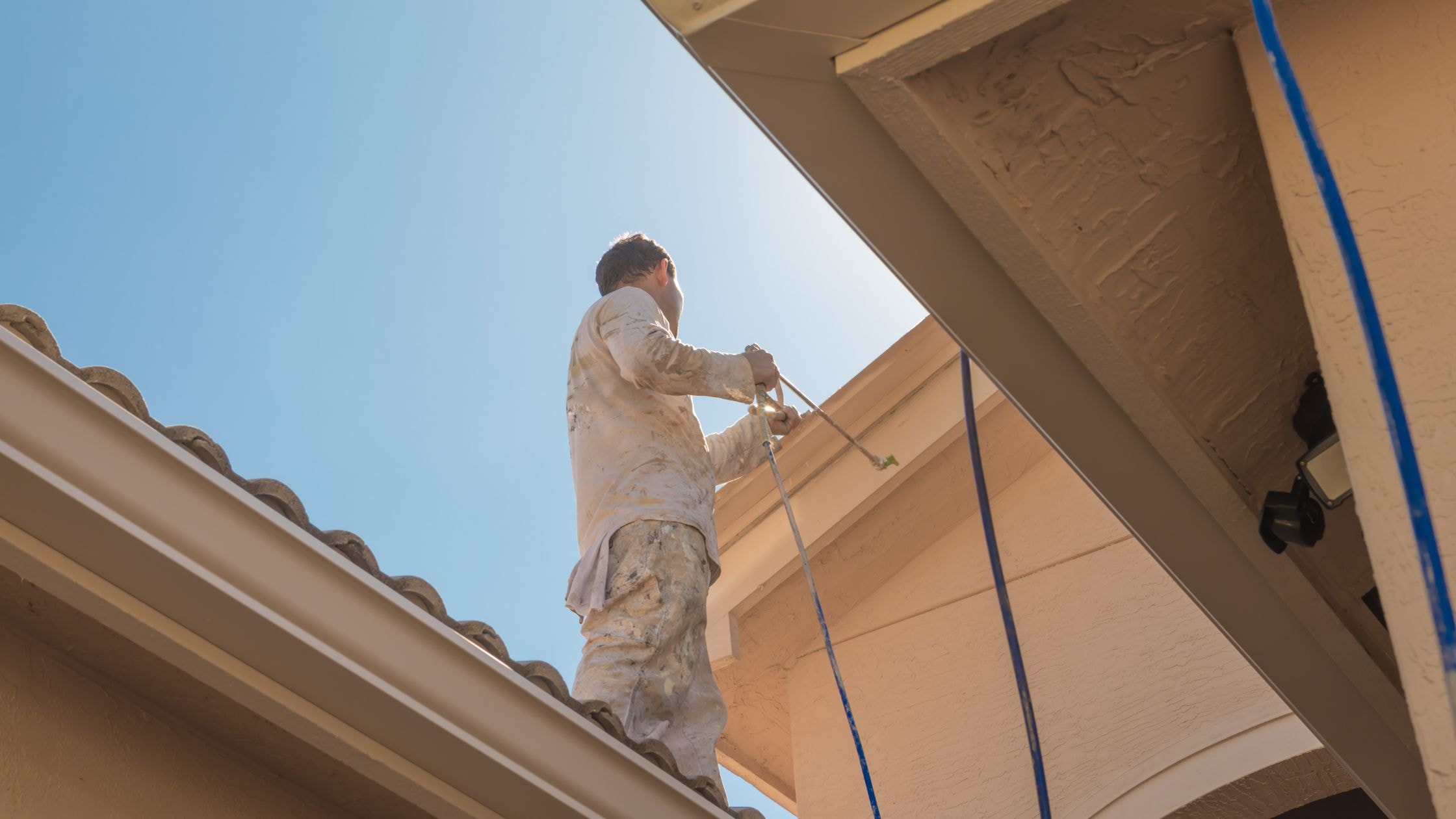
Tips for choosing the right primer
If you’re painting a project on galvanized metal roofs, opt for a galvanized metal primer. This type of primer is specifically formulated to adhere to these roofs, providing a foundation that helps the paint bind well to the surface.
For a rusty metal roof, consider using a rust-inhibitive primer that seals rust spots and prevents further corrosion. Using a primer will help the roof’s overall appearance and extend its lifespan. The primer must be compatible with the paint type you plan to use. If it’s not compatible, the paint may peel off the primer and you’ll end up with to maximize the efficacy of your paint system and enhance the overall energy efficiency of the metal roof.
Tips for choosing the right paint
When selecting the best paint for your project, opt for a paint type specifically designed for metal roofing, such as acrylic latex paint or an oil-based paint or alkyd paint. These options are highly durable and formulated to adhere well to metal surfaces, protecting against UV rays and rust. For galvanized roofs, consider using a galvanized metal primer before applying the top coat to ensure optimal adhesion and rust prevention. A DTM (direct-to-metal) paint is an excellent choice for achieving long-lasting results and better coverage, ensuring that your metal roof withstands the test of time against weather elements. Always check the labels at your local hardware stores to confirm that the paint and primer are suitable for the specific metal used in your roof and that they meet your energy efficiency and aesthetic needs.
Tips for best application practices
When applying paint to your metal roof, adhering to best application practices is crucial for achieving a professional-quality finish. First, ensure that the roof surface is meticulously cleaned; pressure washing is ideal for removing old paint and debris, allowing new paint to adhere properly. For optimal results, use a paint sprayer, which can evenly distribute paint over corrugated metal and standing seam surfaces more efficiently than traditional paint rollers. When using a sprayer or a paint roller, apply primer first. This ensures a solid base that enhances the durability of the topcoat. Always apply paint in thin, even coats, allowing each layer to dry thoroughly before applying the next. This method avoids the formation of a thick coat, which can crack and peel over time. Be mindful of the weather conditions, as high winds or high humidity can affect the drying process and the overall quality of the finish.
Materials Needed for Metal Roof Painting
Essential Cleaning Supplies for Metal Roofs
Gathering the right cleaning supplies before you start the roof painting process helps ensure your roof surface is properly prepared. Essential cleaning tools include a pressure washer to efficiently power wash away old paint, dirt, and debris.
For areas with stubborn grime or loose paint, a paint scraper and a wire brush are indispensable for thorough rust removal and smoothing the surface. To remove dirt and grease, a diluted vinegar solution can be an effective and eco-friendly cleaning agent.
Ensuring that the metal roofing is free of contaminants and old paint allows the new paint adheres properly, providing a clean, robust base for the new coating, enhancing the roof’s appearance and longevity.
Repair Tools to Update Your Roof's Appearance
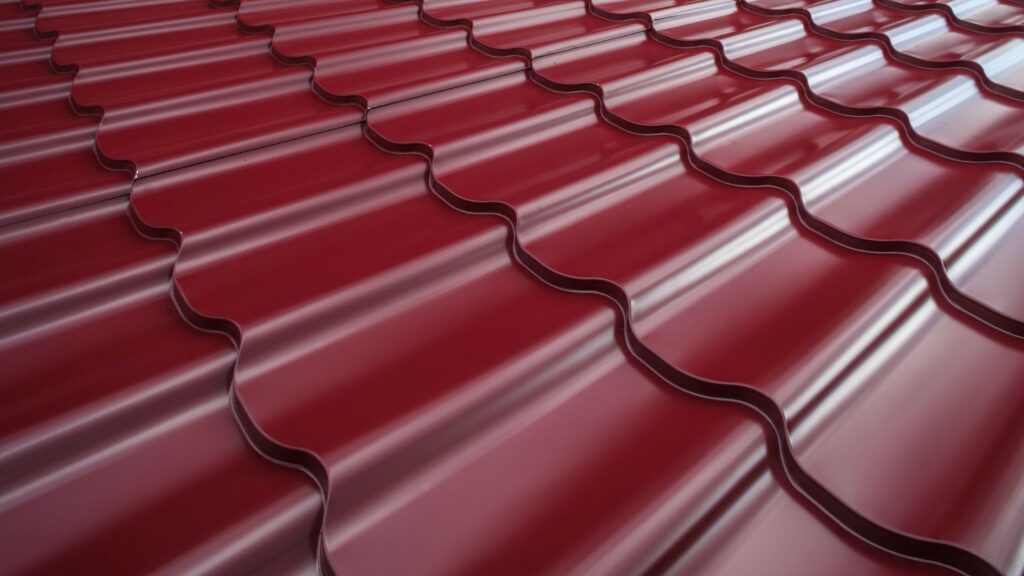
When updating the appearance of your existing metal roof, having the right repair tools helps ensure a successful outcome.
Essential tools include metal patching materials and a wire brush or sandpaper, which are invaluable for addressing any rust spots or areas where old paint has become loose. These tools allow you to effectively remove rust and smooth out the roof surface, creating an ideal base for new paint to adhere. Additionally, using a paint scraper can help in removing old paint more thoroughly, especially if the existing coat has started to peel off.
Proper preparation using these tools not only enhances the roof’s appearance but also ensures the longevity and effectiveness of the new coating, making your metal roof highly durable and energy efficient.
Common Painting Supplies for Metal Roofing
When undertaking a metal roof painting project, having the right supplies is essential to ensure a successful outcome. Key items include:
A high-quality metal primer ensures that the paint adheres properly and provides a robust foundation for the topcoats.
You’ll also need paint specifically formulated for metal roofs, such as acrylic latex paint or oil-based alkyd paint, which is known for its durability and ability to withstand harsh weather.
For the application, paint brushes and rollers are indispensable for a controlled and even application, especially in areas that require precision.
Alternatively, spray equipment can be used for faster and more uniform coverage, although this is optional. These tools and materials are integral to achieving a professionally painted metal roof that not only looks great but also extends the roof’s lifespan and enhances its energy efficiency.
Safety Gear For a Successful Painted Metal Roof
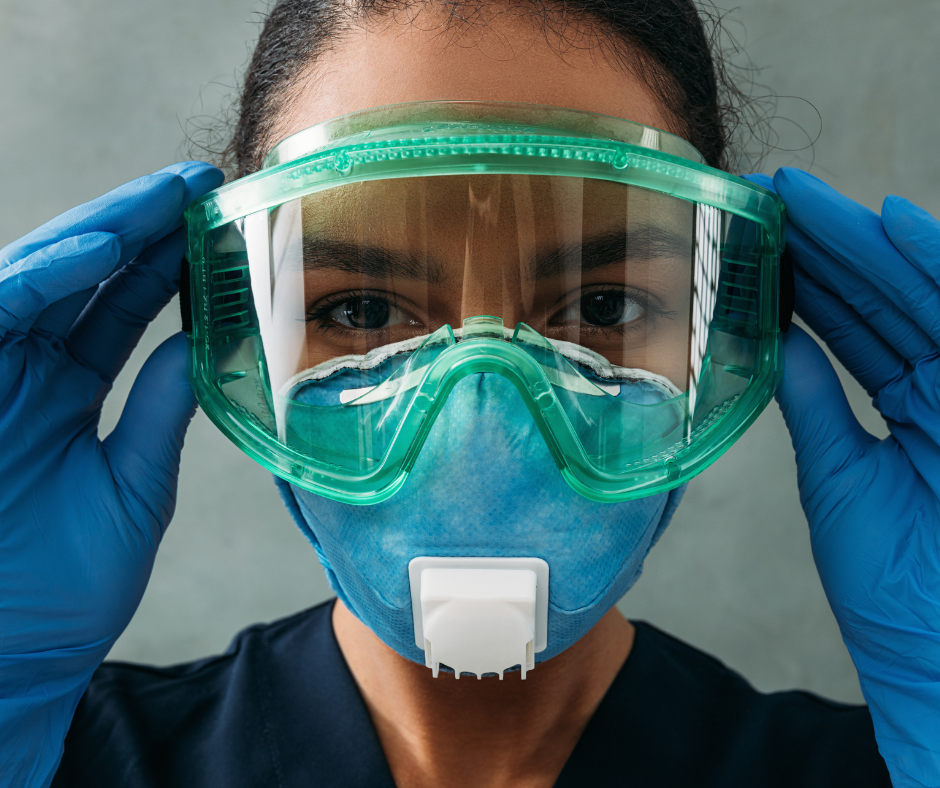
When embarking on a painting project for your metal roof, prioritizing safety precautions is important, especially when working at heights or around power lines. Essential safety gear is necessary to ensure a successful and safe completion of your new roof painting.
Gloves are indispensable to protect your hands from sharp metal edges and the chemicals in paint.
Safety goggles shield your eyes from harmful splashes and debris, which is vital during the rust removal or pressure washing stages.
A harness is critical for those working with steep-pitch roofs or any roof where a fall could occur. This safety gear should be securely fastened to a secure point, ensuring that any slip or misstep doesn’t lead to a severe accident. Together, these pieces of safety equipment help protect you from common hazards associated with roofing projects, allowing you to focus on applying a new coating safely and effectively.
Learn How to Paint a Tin Roof
Painting a tin roof requires a specific approach due to its unique characteristics and material properties. Whether you’re refreshing an old roof or enhancing a newer one, understanding how to correctly paint a tin roof can significantly improve its durability and appearance, while extending its lifespan and adding value to your property.
Expert Tips When Painting Metal Roofs
Choose the Right Time to Paint a Metal Roof
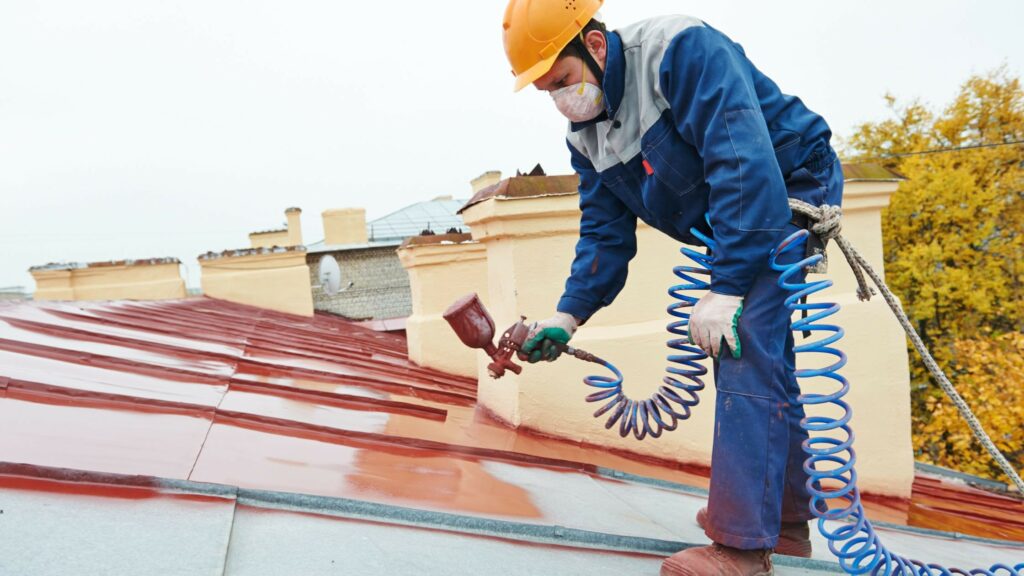
Choose the right time to paint a metal roof to ensure the paint adheres properly and achieves a durable finish.
Weather considerations play a significant role; ideally, start painting when there is a clear forecast without rain or high winds, which can disrupt the painting process and affect the drying time.
Temperature and humidity levels are also vital; the best conditions for painting metal roofs are during mild, dry days. Too much humidity can prevent the paint from setting correctly, while extreme temperatures can cause the paint to dry too quickly or slowly, compromising the quality of the finish.
Therefore, checking the weather and planning accordingly can make a substantial difference in the success of your metal roof painting project.
Use High-Quality Materials for Your DIY Painting Project
For your painting project on metal roofs, use high-quality materials to ensure long-lasting results and superior coverage. Opt for the best paint and primer, specifically designed for metal roofing, such as galvanized metal or corrugated metal, which can significantly affect the durability and efficacy of your new coating.
High-quality metal primers and acrylic latex paints or oil-based alkyd paints are essential for establishing a robust, adherent base that prevents rust and withstands harsh weather elements.
Additionally, investing in top-grade paint rollers, brushes, or a paint sprayer will facilitate smoother application and a better finish. These will help reflect sunlight, enhance the roof’s appearance, and ultimately contribute to your home’s energy efficiency.
By choosing premium materials, your painted roof looks professional and will also enjoy an extended lifespan.
Ensure Proper Ventilation
Ensuring proper ventilation during the metal roof painting process is critical for safety and achieving optimal results.
When using paint products, especially oil-based alkyd paint, which can emit strong fumes, maintain good airflow to prevent inhaling toxic chemicals. Ventilation also plays a crucial role in enhancing the drying time of the paint applied to your metal roof.
Whether using a paint roller or a paint sprayer, keep the area well-ventilated; this not only ensures your safety but also helps the paint adhere better and dry more uniformly. Properly ventilated conditions prevent moisture buildup, which can affect the longevity and efficacy of the new coating, ultimately contributing to the roof’s appearance and energy efficiency.
Can You Paint a Metal Roof? Yes!
Recap of the steps involved in painting a metal roof:
Embarking on a metal roof painting project involves several key steps, starting with the thorough cleaning of the roof surface using pressure washing to remove old paint and debris, followed by rust removal, especially if you’re dealing with a rusty roof.
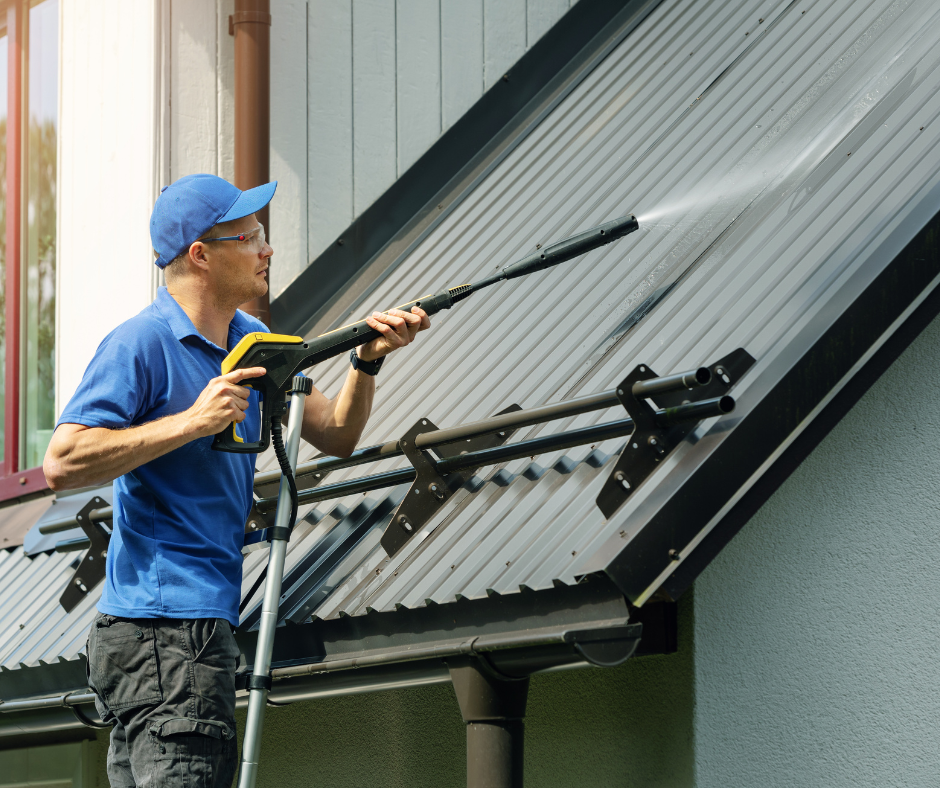
Next, apply a galvanized metal primer to ensure that the new paint adheres well. Choose the best paint for your roof. Depending on the size and texture of your roof, apply the paint using a paint roller or a paint sprayer. Finish by ensuring that each coat is evenly applied and allowed proper time to dry.
Final thoughts on the benefits of painting a metal roof for longevity and aesthetics
Painting your metal roof is not just a maintenance task; it’s an investment in enhancing your home’s curb appeal and extending the roof’s lifespan.
A new coating of paint protects the metal from harsh UV rays, rain, and potential rust spots, ensuring energy efficiency and maintaining the roof’s structural integrity. Moreover, a painted roof contributes to overall home aesthetics, reflecting your home’s personality and style.
Given these benefits, starting your roof painting project now makes sense. It safeguards your asset, boosts its functionality, and enhances its appearance, all while potentially increasing your home’s market value.
Freshly painted roofs can also contribute to improved energy efficiency, as the reflective properties of certain paints can significantly decrease cooling costs in warmer months. By investing time and resources now, you ensure that your roof remains in top condition, safeguarding your home against environmental factors and elevating its appeal for years to come.
